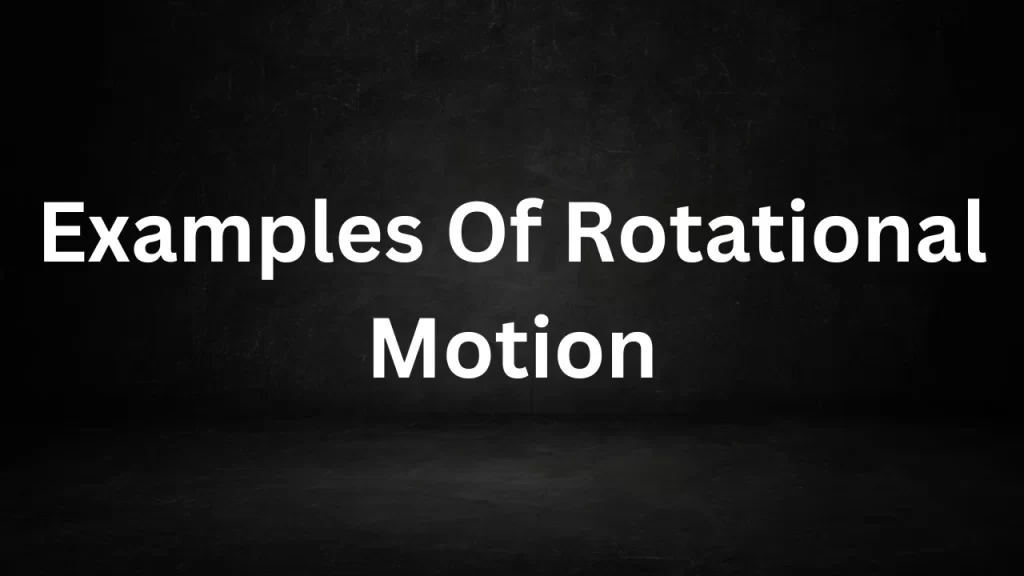Tag: rotational dynamics examples
Examples Of Rotational Motion
Examples Of Rotational Motion: Rotational motion refers to the movement of an object as it spins or rotates around an axis. It is a common phenomenon in our everyday lives and can be observed in various contexts. Here are some examples of rotational motion:

Examples Of Rotational Motion
- Spinning Top: When a spinning top is set in motion, it rotates around its central axis, demonstrating rotational motion. The top’s stability depends on the conservation of angular momentum.
- Earth’s Rotation: The Earth rotates on its axis, causing day and night cycles. This is a fundamental example of rotational motion that affects our daily lives.
- Rolling Wheel: When a wheel rolls, it rotates around its central axis as it moves forward. This is a combination of translational and rotational motion. For instance, a car’s wheels rotate as the car moves forward.
- Rotating Fan: The blades of a fan rotate around a central hub when the fan is turned on. This circular motion creates airflow and cools the room.
- Spinning Gyroscope: A gyroscope is a device used in navigation and stabilization systems. When a gyroscope is spun, it exhibits stable rotational motion, resisting changes in orientation.
- Planet and Moon Rotation: Celestial bodies like planets (e.g., Jupiter) and moons (e.g., our Moon) rotate around their own axes. Observing these bodies through telescopes can provide evidence of rotational motion.
- Rotating Drill Bit: When using a power drill, the bit at the end rotates rapidly to drill holes in materials like wood, metal, or plastic. This is a practical application of rotational motion.
- Turbines: Wind turbines and water turbines harness the power of rotational motion to generate electricity. Wind turbines have large blades that rotate in the wind, while water turbines have blades turned by flowing water.
- Record Player: In a vinyl record player, the record rotates around a central axis, and a needle or stylus follows the grooves on the record, producing sound. This demonstrates rotational motion in entertainment technology.
- Ballet Pirouette: During a ballet pirouette, a dancer spins around one foot while maintaining a fixed axis. This is a graceful and controlled example of rotational motion in performing arts.
- Roller Coaster Loops: In a roller coaster ride, when the car goes through loops or corkscrews, it experiences rotational motion as it spins around different axes, providing thrill and excitement to riders.
These examples illustrate the diverse ways in which rotational motion is encountered in the natural world, technology, and everyday activities.
Read More
- Addition And Subtraction Of Fractions
- Difference Between Asteroid And Meteoroid
- Class 6 Maths Question Paper With Solutions NCERT PDF
- Sample Question Paper For Class 6 CBSE English Grammar
- NCERT Maths Book Class 6 Solutions PDF Free Download
Frequently Asked Questions (FAQs) Examples Of Rotational Motion
What is rotational motion?
Rotational motion is the movement of an object as it spins or rotates around a fixed axis. It involves the circular motion of an object’s parts around a central point.
What is the difference between rotational and translational motion?
Translational motion involves the linear movement of an object from one point to another, while rotational motion involves the spinning or rotating of an object around an axis without changing its position.
What are some real-world examples of rotational motion?
Examples of rotational motion include spinning tops, the Earth’s rotation causing day and night, rolling wheels, rotating fans, and spinning gyroscopes, among others.
How does rotational motion apply to machinery and technology?
Rotational motion is essential in machinery such as engines, drills, and turbines. Engines use pistons that rotate crankshafts, drills have rotating bits, and turbines harness rotational motion to generate electricity.
What is angular momentum in rotational motion?
Angular momentum is a property of a rotating object and depends on its moment of inertia and angular velocity. It is conserved in the absence of external torques, and changes in angular momentum can affect an object’s rotational motion.